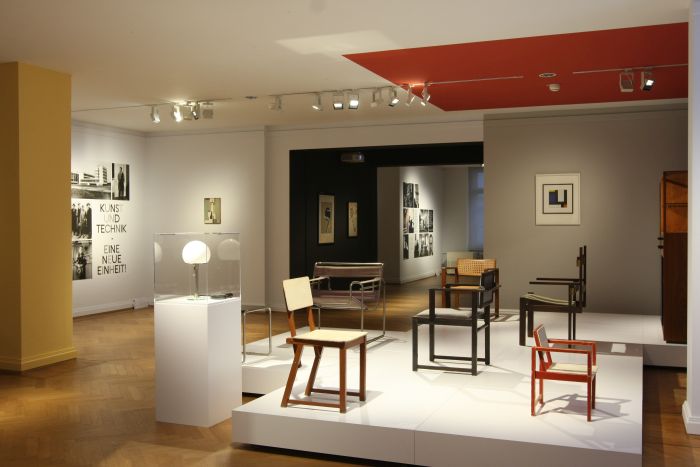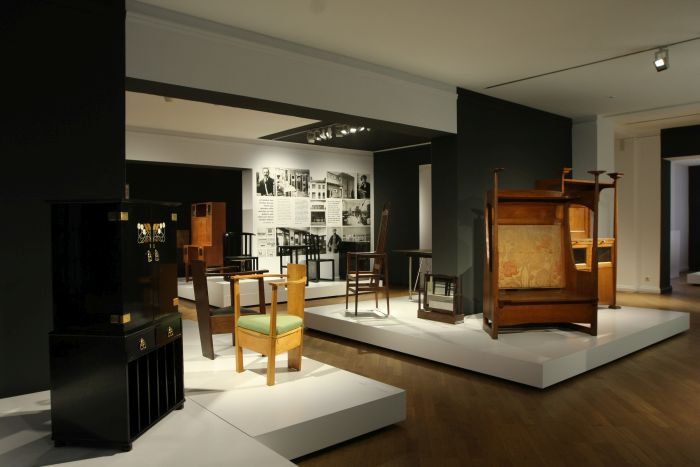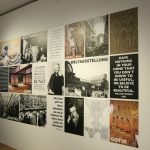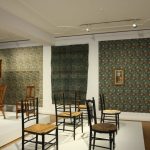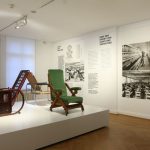From Arts and Crafts to the Bauhaus. Art and Design – A New Unity! @ The Bröhan Museum Berlin
Despite what some may have us believe, Bauhaus didn’t appear one morning from the slowly clearing mists of the Ilm valley; rather, and for all its lasting allure, Bauhaus ’twas but a moment on a longer, wider, international helix. One which began its twisting long before Walter Gropius and his merry band arrived in Weimar, and which continues, winding its way ever onwards, to this day.
With the exhibition From Arts and Crafts to the Bauhaus. Art and Design – A New Unity! the Bröhan Museum Berlin explore the helix as it approached and then, briefly, informed Bauhaus.
As an exhibition From Arts and Crafts to the Bauhaus opens, or perhaps better put, takes as its starting moment, the 1851 Great Exhibition in London, the first such World’s Fair and one of the clearest signals of the advancing, unstoppable, industrialisation of that period.
And a rapidly advancing global industrialisation which is one of three developments quoted by the exhibition curators as being influential, critical?, in the developments in art and architecture that occurred in the last decades of the 19th and first decades of the 20th centuries.
The second development was, arguably, driven by the developing industrialisation, and equally arguably driven by the decline of the European dynastical monarchical system: the appearance of a powerful middle class and, almost as an inevitable opposing reaction, if you will, a proof of Newton’s Third Law functioning in social as well as physical systems, the increasing presence, and political, if not economic, power, of the working class. And both of which provided in their own ways new perspectives, and posed new questions, for the creatives of the day.
The third factor is, as you all know, Japan; a subject much discussed in these pages, and a nation whose return to the international community in the second half of the 19th century following the ending of neigh-on 200 years self-imposed Sakoku isolation brought with it all manner of new aesthetic, material, constructive and esoteric impulses. A further, fourth, point that Bröhan Museum director and exhibition curator Dr Tobias Hoffmann is keen to underscore is the chaos of styles, or perhaps better put, styleless abuse of historic styles, that so define art and architecture in the early/mid 19th century; a chaos that, thankfully, increasing numbers of artists and architects began to understand as such, and, arguably buoyed by the new professional possibilities of industrial production, sought to move society away from.
In many regards this movement away from the chaos and affront of historicism to the reduction (and affront?) of the inter-War functionalists, is the journey on which From Arts and Crafts to the Bauhaus takes the visitor.
Running essentially chronologically, though not exactly, for no helix can, From Arts and Crafts to the Bauhaus begins in England of the mid-19th century with a discussion of the works and ideas of William Morris and his associates; works and ideas which, and at the risk of generalising to the point of untruth, were about the relationship of the object to user in an age of increasing industrialisation, the consequences of industrial production for contemporary society, about preserving craft over industry, and works and ideas which not only influenced a new generation of English artists, but which were taken up commercially by Liberty’s of London, from where they were disseminated to a global public and became the popular face of the Arts and Crafts movement.
Following the helix over countries such as Scotland, Holland, Germany and Austria, specifically Vienna, From Arts and Crafts to the Bauhaus builds its narrative up gradually as it moves, not slowly, it skips along at a good old pace, while always leaving more than enough time and space for your own considerations, but the development of the narrative is gradual, explaining as it goes in clear bilingual English/German texts not only how, for example, the idea of the Gesamtkunstwerk evolved in that era, but also how ideas of form, decoration, aesthetics, functionality and construction evolved as the society in which they were being posed evolved.
And then we reach Adolf Loos and his comparison of ornamentation with crime. OK maybe not as directly as legend has it, but he did vocally, and influentially, proclaim his extreme disquiet at the gratuitous use of ornamentation. Including a long, considered denouncement of the tattoo, and which poses the question as to how Loos would cope in contemporary society where getting ink is much a moment in any life as marriage was in previous society.
Having brought the visitor through the evolution from a semi-industrial production that was essentially craft production at the start of the narrative, over the ever increasing influence of not only the machine but new aesthetic, formal and functional understandings, the helix arrives at furniture as an industrial, macine made, product, something very neatly demonstrated by the work of Richard Riemerschmid, including a presentation of a self-construct, demountable, table, and 1905/1906 wardrobe created for the Dresdner Werkstätten für Handwerkskunst, and which is, as it were, blown out to show the simplified, standardised, machine, construction system.
From such developments it is but a short hop to the establishment of the Deutscher Werkbund, one of the clearest examples of artists working for industry to improve aesthetic and functional standards, and an organisation founded, essentially, as a reaction to the extremely poor quality of German export goods, back in the days when “Made in Germany” was an insult rather the valuable marketing label it is today. And then following the briefest of mentions of De Stijl, or at least Gerrit T. Rietveld as unitary representative of De Stijl, one arrives at Bauhaus. Or more accurately put one arrives at Bauhaus I, Bauhaus II and Bauhaus III: early Weimar, late Weimar, Dessau. And a very nice separation of the 14 years of the school’s, arguably schools’, existence into three chapters, a separation which make very clear that despite the relatively definitive way the phrase is used today, the way Bauhaus is used as a determinative, Bauhaus was anything but static. Which arguably it couldn’t be, being as it was an idea carried along by a wide range of individuals on a continually extending, ever further winding helix.
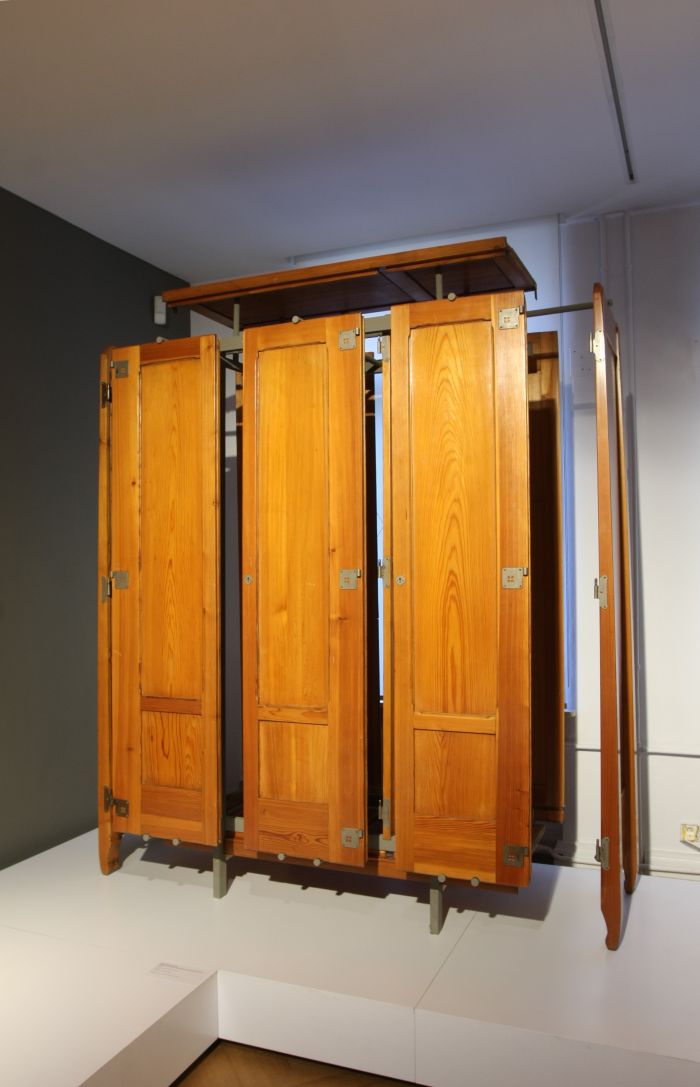
An “exploded” wardrobe by Richard Riemerschmid, as seen at From Arts and Crafts to the Bauhaus. Art and Design – A New Unity, The Bröhan Museum Berlin
Presenting largely furniture, not exclusively but largely, particularly in the first sections, the further it progresses into the 20th century the more diverse the presentation becomes; and which isn’t a complaint, far from it. On the one hand furniture is an excellent conduit via which to explore and explain social, cultural, technical and aesthetic evolutions over a span of decades; and while in addition to many familiar pieces, From Arts and Crafts to the Bauhaus introduces the visitor to a grand array of much less well known objects, we for our part were particularly taken by a 1875 folding chair by Edward William Godwin, a pair of 1901/1903 armchairs by Mackay Hughes Baillie Scott, an armchair from ca. 1900 by an unknown artist and a 1930 desk by Gerrit T. Rietveld. Amongst many, many other objects.
Similarly, while the exhibition gives space to the well known protagonists of the periods under investigation, including the likes of Peter Behrens, Henry van de Velde, Charles Rennie Mackintosh, Marcel Breuer, Lucian Bernhard, et al it also finds space for several of those who are less well known, if every bit as interesting, including, and amongst others, Ford Madox Brown, Oskar Strnad, Jan Eisenloeffel or Charles F.A. Voysey.
Many of you will be way ahead us by now……….
…………….Yes, as an exhibition From Arts and Crafts to the Bauhaus, and somewhat disappointingly, does tend to reaffirm the exclusively male narrative of design of the late 19th/early 20th century. There are very occasional females, Marianne Brandt being one of the more prominent. And while we’re always happy to see works by Marianne Brandt, especially as when in From Arts and Crafts to the Bauhaus they aren’t necessarily the more familiar ones, but rather less seen works, including a fascinating tea caddy for Ruppelwerk Gotha: it is kind of always Marianne Brandt whenever museums mention female inter-War functionalists.
Don’t get us wrong, we understand that female creatives of those decades under consideration were less numerous than their male colleagues, for all in terms of the furniture design that forms the principle focus of the exhibition; and we also understand that despite the very real breath of the presentation, it is a very tight path that has been laid out, only part of the helix is illuminated, a lot remains in darkness, and that by necessity, if you went too wide you’d quickly lose control over the narrative and create a diffuse, discorded presentation, and this limitation as to what is discussed further limits the possibilities for presenting works by female designers, naturally discounts many who could have been brought in; and we also understand that despite the numerous examples of males working for the Hellerau Werkstätten, presenting examples of females who did would be difficult as they are, arguably, currently all on show in Dresden; and we understand that the men presented carried out interesting and important work which deserves to be, must be, celebrated. But despite our understanding, the almost complete lack of female protagonists, for all in the first part of the exhibition, is still very disappointing.
Not because the presence of females would have fundamentally changed the narrative, we don’t believe it would have, in many regards the story told, certainly the flow of the narrative would have been the same; creatives in a given place at a given time tended to move in the same circles, work for similar clients, cooperated, and so formally and stylistically men and women tended to produce similar works at similar times. But the inclusion of more works by female creatives would have made it a more realistic, more probable, certainly more accurate narrative. And in this year when there is so much reflection on the changes in art, architecture and design which the late 19th/early 20th century ushered in, we feel the moment is extremely opportune to reset a few existing conventions.
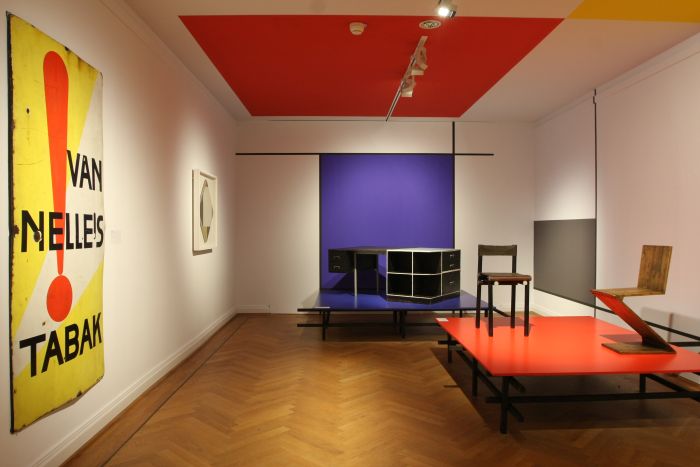
Furniture by Gerrit Rietveld & an advert by Jacob Jongert, as seen at From Arts and Crafts to the Bauhaus. Art and Design – A New Unity, The Bröhan Museum Berlin
Presenting some 300 objects, From Arts and Crafts to the Bauhaus does suffer slightly from the peculiarities of the Bröhan Museum’s exhibition space, architectural idiosyncrasies which tend to dictate an object on pedestals format. On the one hand positive as it allows for a natural sub-division into convenient chunks, thus aiding the tempo of the narrative; does however mean you spend a lot of time looking at furniture looking back at you, rather than being able to properly inspect and engage with it. And there are a few pieces well worth a longer conversation, in particular an armchair by Erich Dieckmann which features a delightfully conceived and realised backrest.
The layout however doesn’t district from the flow or the focus on the objects, objects which it is important to remember stand less for the genres to which they belong, and much more for what they represent in terms of the period in which they were produced, the motivations, intentions, positions, questions of the artists who created them, how the ideas inherent within them influenced further generations, and are the basis of their contemporary relevance.
And for all objects which very neatly and succinctly demonstrate how over the course of a couple of generations questions about production, questions about form, questions about construction, questions about aesthetics, questions about decoration, questions about functionality became increasingly questions about production & form & construction & aesthetics & decoration & functionality, how art as expressed through craft became art as expressed through design, a process which, in effect, brought us from the wooden furniture of late 19th century England to the steel tubing of the inter-War European functionalist; two forms of furniture which despite their very obvious differences, are, in many, if not all, regards, underscored by similar questions, positions, intentions, motivations; the answers to and embodiment of which are however affected by evolving social, cultural, economic and technological developments. That furniture, that design, doesn’t exist for itself. Or at least honest furniture and honest design doesn’t.
And thereby also helps us understand that Bauhaus continues to this day, or more accurately put the helix that brought us from Arts and Crafts to the Bauhaus continues to this day; that just as many of the works and ideas of Morris, Dresser, Voysey et al may be located, albeit abstracted, reimagined and rethought, in the works of the inter-War functionalists, they can also still, in many regards, be found in our contemporary furniture and design. Or, again, at least in the honest works.
Not doing anything particularly new, but doing it with an infectious, and very passionate, fervour, one that positively encourages you to undertake more investigation on your own, From Arts and Crafts to the Bauhaus provides for an entertaining and easily accessible introduction to the development of art, architecture and design in the late 19th/early 20th century: if, as we say, you must at all times be very, very aware that what you are viewing is very, very male.
From Arts and Crafts to the Bauhaus. Art and Design – A New Unity! runs at the Bröhan Museum, Schloßstraße 1a, 14059 Berlin until Sunday May 5th.
Full details, including information on the accompanying fringe programme, can be found at www.broehan-museum.de
- The Bröhan Museum mood board, as seen at From Arts and Crafts to the Bauhaus. Art and Design – A New Unity, The Bröhan Museum Berlin
- From Arts and Crafts to the Bauhaus. Art and Design – A New Unity @ The Bröhan Museum Berlin
- On the left a cupboard by Marcel Breuer, as seen at From Arts and Crafts to the Bauhaus. Art and Design – A New Unity, The Bröhan Museum Berlin
- Works by Peter Behrens (l) & Alfred Grenander (r), as seen at From Arts and Crafts to the Bauhaus. Art and Design – A New Unity, The Bröhan Museum Berlin
- Chairs by Ford Madox Brown , as seen at From Arts and Crafts to the Bauhaus. Art and Design – A New Unity, The Bröhan Museum Berlin
- In the middle a chair by Oskar Strnad, as seen at From Arts and Crafts to the Bauhaus. Art and Design – A New Unity, The Bröhan Museum Berlin
- Steel tube objects, as seen at From Arts and Crafts to the Bauhaus. Art and Design – A New Unity, The Bröhan Museum Berlin
- Works by Richard Riemerschmid, as seen at From Arts and Crafts to the Bauhaus. Art and Design – A New Unity, The Bröhan Museum Berlin
- Josef Hoffmann and Charles Rennie Mackintosh, as seen at From Arts and Crafts to the Bauhaus. Art and Design – A New Unity, The Bröhan Museum Berlin
- Bauhaus Weimer art and cermaics, glass, stonewear, as seen at From Arts and Crafts to the Bauhaus. Art and Design – A New Unity, The Bröhan Museum Berlin
- A cupboard and folding chair by Edward William Godwin, as seen at From Arts and Crafts to the Bauhaus. Art and Design – A New Unity, The Bröhan Museum Berlin
- Chairs by Erich Dieckmann, as seen at From Arts and Crafts to the Bauhaus. Art and Design – A New Unity, The Bröhan Museum Berlin
- Examples of works by Deutscher Werkbund artists, as seen at From Arts and Crafts to the Bauhaus. Art and Design – A New Unity, The Bröhan Museum Berlin
- Works by Charles Rennie Mackintosh, save the chair on the left, that is by an artist unknown, as seen at From Arts and Crafts to the Bauhaus. Art and Design – A New Unity, The Bröhan Museum Berlin
- From Arts and Crafts to the Bauhaus. Art and Design – A New Unity @ The Bröhan Museum Berlin
- Chairs by Josef Hoffmann, Charles Bevan & Marcel Breuer, as seen at From Arts and Crafts to the Bauhaus. Art and Design – A New Unity, The Bröhan Museum Berlin
- On the right a tea caddy by Marriane Brandt for Rupplewerk Gotha, as seen at From Arts and Crafts to the Bauhaus. Art and Design – A New Unity, The Bröhan Museum Berlin
- In the foreground a shop cupboard by Eduard Josef Wimmer-Wisgrill & Wilhelm Niedermoser, as seen at From Arts and Crafts to the Bauhaus. Art and Design – A New Unity, The Bröhan Museum Berlin
Tagged with: Arts and Crafts, Bauhaus, Berlin, Bröhan Museum, From Arts and Crafts to the Bauhaus. Art and Design – A New Unity!
